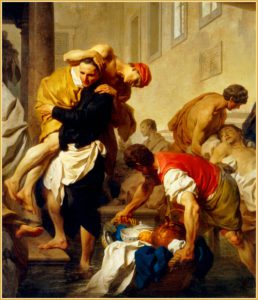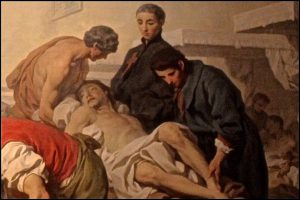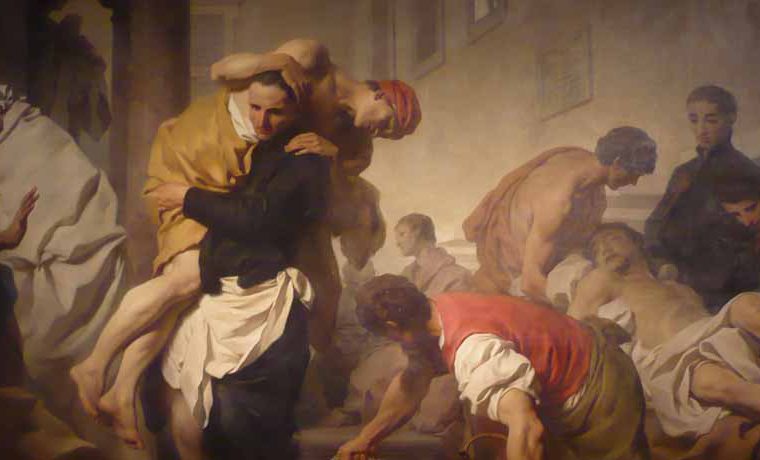 Visiting the Sick – Pierre Subleyras from the catalogue La misericordia nell’arte, Itinerario giubilare tra i Capolavori dei grandi artisti italiani (‘Mercy in Art, Jubilee Itinerary amongst the Masterpieces of Great Italian Artists’, edited by Maria Grazie Bernardini and Mario Lolli Ghetti (Gangemi Editore, Rome, 2016)
Visiting the Sick – Pierre Subleyras from the catalogue La misericordia nell’arte, Itinerario giubilare tra i Capolavori dei grandi artisti italiani (‘Mercy in Art, Jubilee Itinerary amongst the Masterpieces of Great Italian Artists’, edited by Maria Grazie Bernardini and Mario Lolli Ghetti (Gangemi Editore, Rome, 2016)
Pierre Subleyras (Saint Gilles du Gard 1699–Rome 1749): St. Camillus de Lellis saves the sick of the Hospital of the Holy Spirit Sassia during the flooding of the Tiber of 1598.
1746 oil on canvas, 172x248cm
By the decree of 14 April 1741, Benedict XIV reorganised the criteria for the expenditure on the processes and ceremonies for the beatification and canonisation of saints, cutting back on the waste and the corruption of the Roman Curia. The reform also revised in detail the contents and the number of paintings which, by custom, the various Cardinals involved in a process, as well as the Pope, could expect as a right. In particular, on the occasion of the ceremony of a canonisation it was established that the Supreme Pontiff was to be given a large picture that depicted ‘either a miracle or the glory of the saint, or some virtue practised by him’.
In 1746, while the solemn canonisation of Camillus de Lellis was being prepared, the Order of the Camillians, respecting what was prescribed, proceeded to commission a painting to be given to Benedict XIV. This large canvas, produced by Pierre Subleyras during the same year, which is today to be found at the Museum of Rome, portrays the saint as he strives to save the patients of the Hospital of the Holy Spirit in Sassia during the flooding of the Tiber during the night of 23 December 1598. This works attests to an adherence to the liturgical and ceremonial rules of the Church of the epoch and, at the same time, reflects the cultural and artistic climate of the pontificate of Lambertini.
The author of this work, who was trained at Toulouse at the school of Antoine Rivals, settled in Italy as a pensionnaire of the Academy of France from 1728 onwards. An original interpreter of the classicist component of European art of that time, Subleyras was welcomed and appreciated in the capital and obtained prestigious commissions such as the official portrait of Benedict XIV of 1740 and ‘The Mass of St. Basil’ for the basilica of St. Peter’s of 1744 (at the present time kept in Rome at S. Maria degli Angeli).
In his painting for the Camillians, the artist conceived of a work of great pedagogic and promotional efficacy, interpreting to the full the spirit of the magisterium of Camillus, celebrated by his biographers as vir misericordiae. This saint, who lived in the second part of the sixteenth century, dedicated his life to caring for the sick and – going against the mainstream outlook of the Catholic hierarchies – promoted the essential role of religious in providing material care to the sick. In 1586, indeed, he obtained papal approval for the foundation of the Order of the Regular Clerics Ministers of the Sick, also known as the Camillians.
 The dramatic scene of the rescuing of the patients is described by Subleyras within the coordinates of a balanced composition that is marked by the controlled gestures and expressions, without emphasis, of the figures who are portrayed. This indicates thought about the models of the Italian artistic tradition. This French artist re-worked tested iconographies such as that of the ‘Depositions of Christ’ of Annibale Carracci with the half-naked patient lying on a stretcher on the right of the scene, or of ‘Enea e Anchise’ of Federico Barocci (Galleria Borghese, Rome) with the figure of Camillus with a patient on his shoulders, on the left. This web of references, the idealisation of types, and the ennobling of effects all contribute to the heroic transfiguration of the earthly virtues of self-denial for the weakest that had characterised the existence of the chief protagonist. On the other hand, the naturalistic sensibility of Subleyras emerges in the extraordinary still life of the basket in the foreground. With its disorder of miserable remains of food, dishes and rags, held up and almost displayed by the robust arms of a servant in line with a recurrent way of depicting gifts in scenes of sacred art of the sixteenth century, the basket constitutes the figurative and symbolic fulcrum of the painting, an allusion to a reality of suffering and an allegory of human caducity in harmony with the meaning attributed by tradition to still life in a Nordic context.
The dramatic scene of the rescuing of the patients is described by Subleyras within the coordinates of a balanced composition that is marked by the controlled gestures and expressions, without emphasis, of the figures who are portrayed. This indicates thought about the models of the Italian artistic tradition. This French artist re-worked tested iconographies such as that of the ‘Depositions of Christ’ of Annibale Carracci with the half-naked patient lying on a stretcher on the right of the scene, or of ‘Enea e Anchise’ of Federico Barocci (Galleria Borghese, Rome) with the figure of Camillus with a patient on his shoulders, on the left. This web of references, the idealisation of types, and the ennobling of effects all contribute to the heroic transfiguration of the earthly virtues of self-denial for the weakest that had characterised the existence of the chief protagonist. On the other hand, the naturalistic sensibility of Subleyras emerges in the extraordinary still life of the basket in the foreground. With its disorder of miserable remains of food, dishes and rags, held up and almost displayed by the robust arms of a servant in line with a recurrent way of depicting gifts in scenes of sacred art of the sixteenth century, the basket constitutes the figurative and symbolic fulcrum of the painting, an allusion to a reality of suffering and an allegory of human caducity in harmony with the meaning attributed by tradition to still life in a Nordic context.
The scene of the rescue takes place in a context that evokes the fifteenth-century Sistine ward, the only (and unhealthy) place for patients prior to the renovation of the Hospital of the Holy Spirit promoted by Benedict XIV which was underway at the time. This painting also celebrated in this way the most important public work of the pontificate of Lambertini which, planned by Ferdinando Fuga in line with extremely innovative criteria, represented a first attempt at reconciling the requests of the orthodoxy of the Roman Curia with the secular requests of nascent medical science.
Rossella Leone















Camillians on Facebook
Camillians on Twitter
Camillians on Instagram